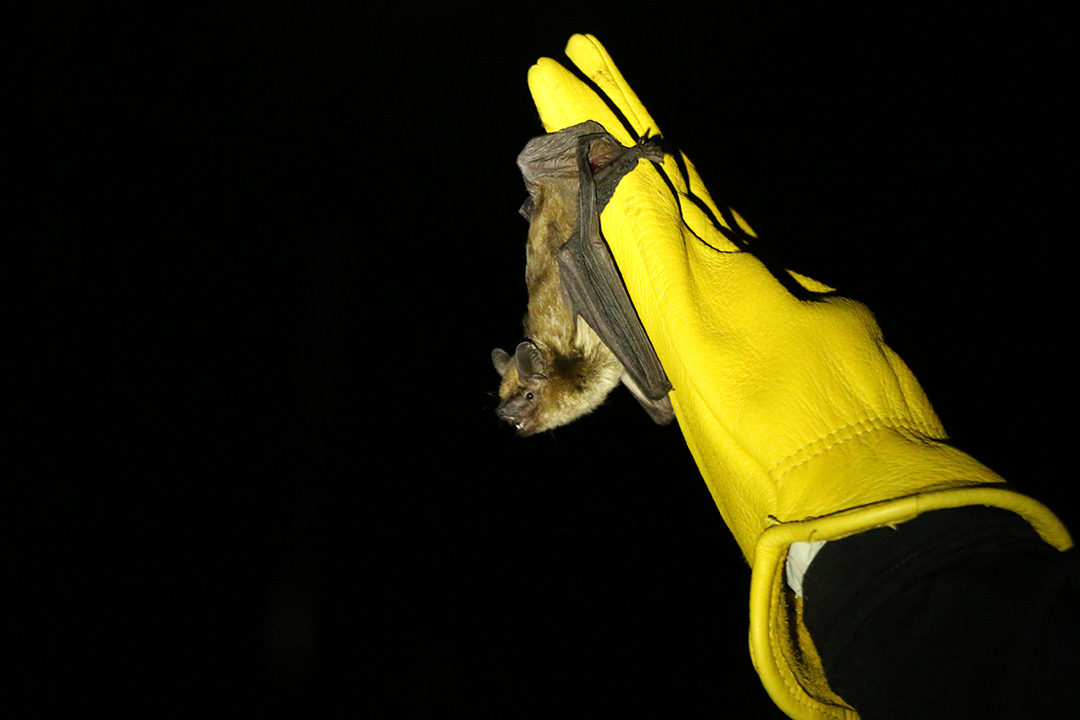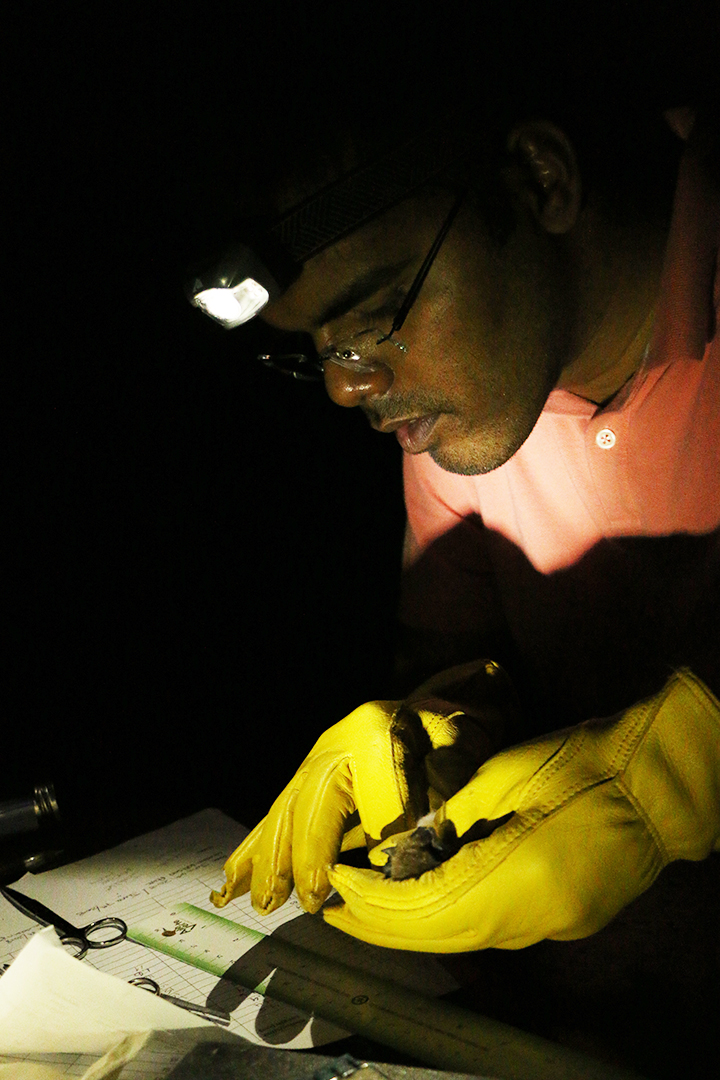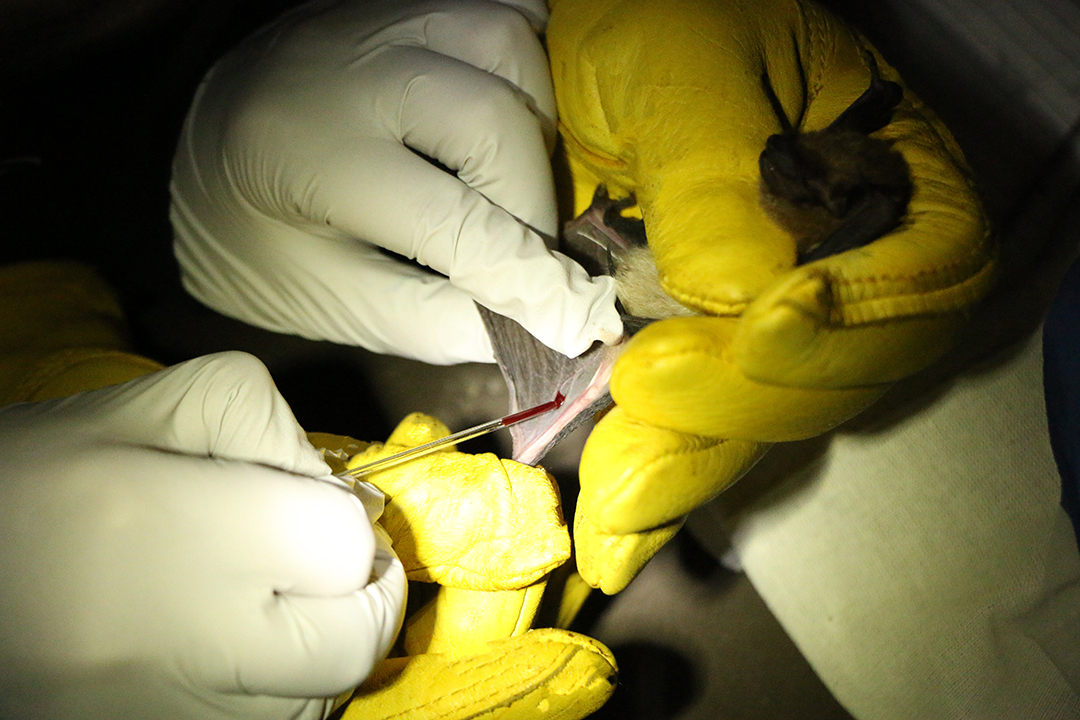
Bats waking up to viral reactivation
I feel like a predator. Only my target isn’t a blood meal – it is something far more precious.
By Caleigh GerowWe sit silently in the dark of night waiting for the spark of excitement that means we’ve caught something. Black against the night sky, our 12-foot nets are invisible to the big brown bats we have set out to capture. We are searching for important information and an increased understanding of these elusive flying mammals. We are hunting for viruses.
***
Recent studies have shown that bats are reservoirs for several deadly viruses that spill over to other species and cause fatal diseases — even though the bats themselves don’t die from these viruses. Right now, the factors leading to such spillovers are poorly understood, and little has been done to study the viruses within their natural and co-evolved bat host.
“This is where our lab comes in,” says Sonu Subudhi of the Western College of Veterinary Medicine’s (WCVM) Department of Veterinary Microbiology. Subudhi, who completed his PhD degree this spring, was part of the research team working on the project. “We are trying to look at this dynamic interaction between the original bat viruses and the bat hosts.”
Our focus is a blood-borne virus known as Eptesicus fuscus herpesvirus (EfHV) – a virus that is found in North American big brown bats. This herpes virus remains latent within the bat host, but when the animal is stressed, the virus can become activated causing disease.
To determine whether hibernation is a contributing factor to the activation of EfHV within big brown bats, we are collecting blood samples from a leg vein of hibernating bats as well as non-hibernating bats captured from the wild around Saskatoon.

***
As the night comes alive with the high-pitched call of a bat caught in our mist net, we jump up and use our headlamps to guide us to the source of the sound. Entangled in the mist net above us is a big brown bat — the reservoir of our viral investigation.
The alarm calls attract more bats to the net, and we are suddenly in the middle of a bat storm. More bats fly into the nets, and we work quickly to remove them and obtain the valuable samples. We must be extremely careful since the bat’s vein can be as thin as a human hair.
Once back in the lab, we will separate our samples into blood cells and plasma. While the blood cells are used to detect viral DNA, the plasma is used to detect antibodies — both provide valuable information for determining the infection status of the bats.
The sampling for the first bat is complete. It fights and bites against our leather gloves, completely unaware of the important information it is providing for us. Once a cotton swab stops the bleeding and the bat becomes calmer, the animal is released back into the night.
But our job is far from complete. More bats are flying into the net, and our night has just begun.
***
Overall, we detected EfHV only in the blood of hibernating bats (10 out of 36 samples, or 27.8 per cent) and not at all in the blood of non‐hibernating bats (zero out of 43 samples). In contrast, the EfHV‐specific antibody titres were higher in the non‐hibernating bats compared to the hibernating bats.
Our study suggests that long periods of hibernation lead to suppression of immunity, and the stress of arousal from hibernation reactivates the virus in bats with lower levels of anti‐viral immunity.
“We can do things here that hardly anyone else in the world can do as far as bat herpes viruses are concerned,” says Dr. Vikram Misra, the WCVM virologist and professor who supervised the study.
“Since we have isolated the virus, we can do a lot of experiments in cultured cells and then apply that knowledge to what is happening to bats that we are catching.”
By understanding how EfHV interacts within its natural bat host, we can determine whether hibernation and the stress of arousal from hibernation can lead to increased virus reactivation and shedding in bats. This important information will help researchers better understand other virus-bat relationships and the factors that cause viruses to spill over to other species — including people.
This study received financial support from WCVM, University of Saskatchewan and the Natural Sciences and Engineering Research Council of Canada (NSERC).

See published research: Gerow CM, Rapin N, Voordouw MJ, Elliot M, Misra V, Subudhi S. “Arousal from hibernation and reactivation of Eptesicus fuscus gammaherpesvirus (Ef HV) in big brown bats.” Transboundary Emerging Diseases. 2018 doi: 10.1111/tbed.13102.
Caleigh Gerow of Victoria, B.C., will begin her third year of veterinary studies in August 2019. Her story is part of a series of articles written by WCVM summer research students. Caleigh was the 2018 recipient of the Faculty Award for Undergraduate Research in the WCVM Department of Veterinary Microbiology.
